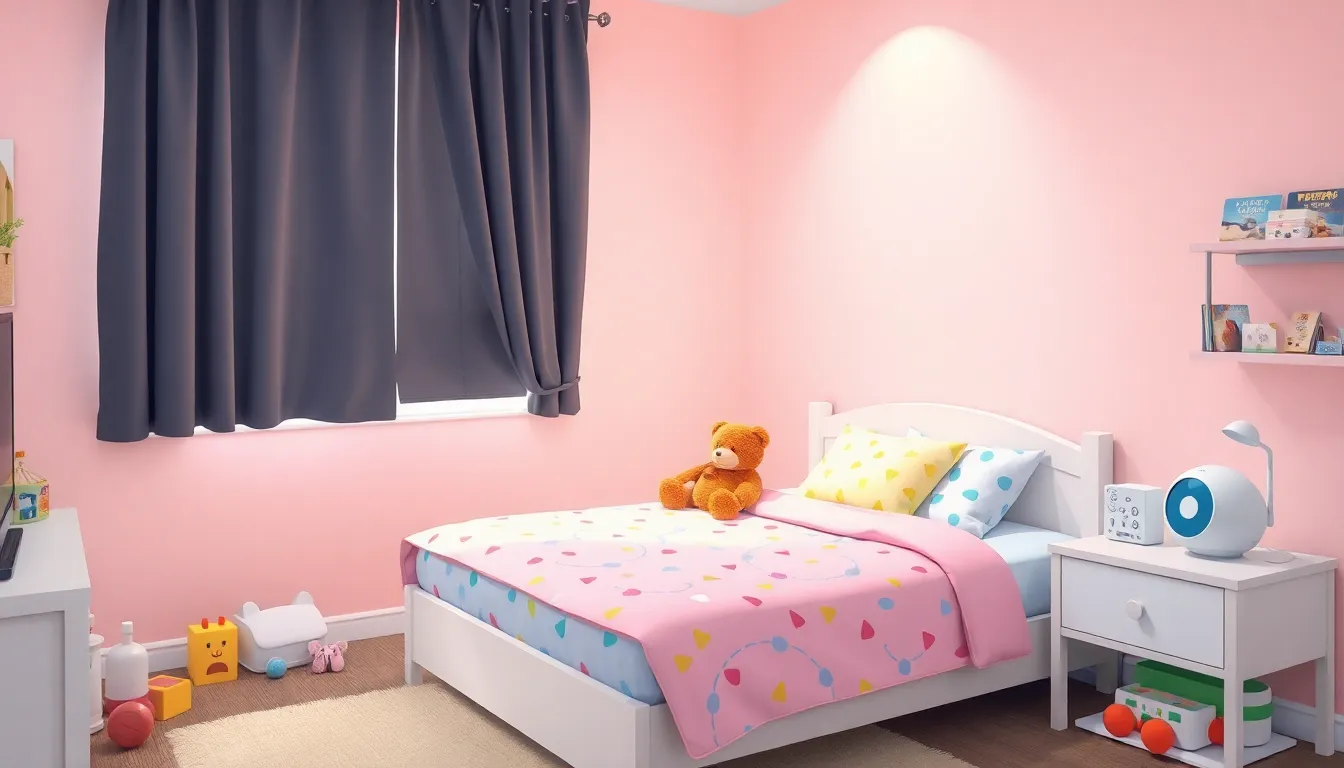Getting kids to sleep can feel like trying to herd cats—chaotic and downright exhausting. With the endless energy of a toddler and the curiosity of a young explorer, bedtime often turns into a battle of wills. But fear not! With the right sleep tips, parents can transform this nightly struggle into a peaceful routine that even the most stubborn little ones can embrace.
Table of Contents
ToggleImportance Of Sleep For Kids
Sleep significantly impacts a child’s health and development. Quality rest fosters growth, emotional regulation, and cognitive function.
Benefits Of Quality Sleep
Quality sleep enhances memory consolidation and learning. During deep sleep, the brain forms new connections, strengthening knowledge retention. Additionally, sleep supports the immune system, reducing susceptibility to illness. A well-rested child exhibits improved focus and behavior, lowering the likelihood of irritability. Balanced sleep patterns also contribute to better physical health, ensuring adequate energy for daily activities.
Consequences Of Poor Sleep
Poor sleep can lead to several negative outcomes. Lack of rest often results in increased mood swings, leading to irritability and difficulty managing emotions. Impaired cognitive function affects learning capabilities, decreasing attention span in school environments. Moreover, chronic sleep deprivation raises the risk of health issues, including obesity and weakened immunity. Behavior problems, such as increased hyperactivity, frequently arise in children who do not get enough sleep.
Creating A Sleep-Friendly Environment

A sleep-friendly environment sets the foundation for healthy sleep habits in kids. Parents can promote a peaceful atmosphere that encourages restful sleep through thoughtful adjustments.
Ideal Room Conditions
Temperature plays a vital role in sleep quality. Keeping the room cool, ideally between 68°F to 72°F, supports easier sleep transitions. Light should also be minimized; blackout curtains or shades can create a dark space conducive to sleep. A comfortable mattress and cozy bedding enhance comfort and relaxation. Adding soft colors to the room can further promote a calm vibe. Parents can encourage personalization with a favorite stuffed animal or blanket to provide additional comfort.
Reducing Noise And Distractions
Noise reduction significantly impacts kids’ ability to fall asleep. White noise machines can mask sudden sounds like traffic or pets. Ensuring electronic devices are off or out of the room helps eliminate distractions during bedtime. Parents may consider using calming sounds or lullabies to create a soothing background. Removing clutter and organizing toys can also provide visual peace in the bedroom. Consistency in bedtime routines reinforces the importance of sleep and helps kids recognize that it’s time to wind down.
Establishing A Consistent Bedtime Routine
Creating a consistent bedtime routine helps children understand when it’s time to sleep. This structure leads to a smoother transition into bedtime.
Steps For A Relaxing Routine
Incorporate calming activities throughout the evening. Start with a warm bath to relax the body, followed by reading a story in a quiet space. Engage children with gentle tasks, like putting away toys, to signal a shift toward bedtime. Establishing a regular sequence fosters familiarity, making the process enjoyable. Incorporate a few minutes of quiet reflection or breathing exercises to help them wind down.
Timing And Duration Considerations
Set bedtimes based on children’s age to ensure they get adequate rest. For toddlers, aim for bed between 7 p.m. and 8 p.m., while school-aged children might benefit from an 8 p.m. to 9 p.m. bedtime. Consistency helps regulate their body’s internal clock. Limit the bedtime routine to about 30 minutes to keep it manageable. Opt for earlier bedtimes if children show signs of tiredness, such as fussiness or difficulty concentrating throughout the day.
Encouraging Healthy Sleep Habits
Fostering healthy sleep habits in children contributes significantly to their overall well-being. Several strategies can enhance their sleep quality and make bedtime a more enjoyable experience.
Limiting Screen Time Before Bed
Establishing screen-free time before bed helps children unwind. Experts recommend shutting down screens at least one hour before bedtime. Engaging in quiet activities, like reading or coloring, provides a calming alternative. Artificial light from screens disrupts natural sleep signals, making it harder for children to fall asleep. Parents often notice improved sleep patterns when electronic devices are excluded from bedrooms.
Promoting Physical Activity During The Day
Encouraging regular physical activity during the day promotes better sleep at night. Outdoor play and structured activities, such as sports, boost energy levels and decrease restlessness. Aim for at least 60 minutes of active play each day; research shows that active children tend to fall asleep more easily. Balancing active time with calm periods helps children wind down effectively. Establishing a routine that includes time for both activity and relaxation supports healthier sleep habits overall.
Addressing Common Sleep Challenges
Children often face specific sleep challenges that can disrupt their nightly rest. Understanding these challenges helps parents implement effective strategies.
Nightmares And Night Terrors
Nightmares commonly affect children, causing them to wake up fearful and distressed. These bad dreams typically occur during the rapid eye movement sleep phase. Night terrors, on the other hand, happen during deep sleep and often involve screaming or thrashing without the child fully awakening. Parents can comfort children experiencing nightmares by calmly discussing their fears after the incident. Offering a nightlight or a comforting item may also provide reassurance. For night terrors, staying calm and ensuring children remain safe until they return to sleep is crucial. If either issue persists, consulting a pediatrician ensures professional guidance is available.
Sleepwalking And Other Disorders
Sleepwalking affects some children, leading them to wander during sleep without awareness. This disorder can pose safety risks, so securing the environment is essential. Removing sharp objects or obstacles is a prudent step. Other sleep disorders, such as insomnia or sleep apnea, may require medical intervention. Signs of insomnia include difficulty falling asleep or frequent wake-ups, while sleep apnea involves pauses in breathing during sleep. Parents should monitor their child’s sleep patterns closely. Observing behaviors like snoring or gasping may indicate apnea, prompting a visit to a healthcare professional. Addressing these disorders early promotes healthier sleep habits and overall well-being.
Establishing healthy sleep habits for kids is vital for their growth and development. By creating a calming bedtime routine and a sleep-friendly environment, parents can significantly improve their children’s sleep quality. Consistency in bedtime and engaging in relaxing activities can make all the difference in transitioning to sleep.
It’s also important to address any sleep challenges that may arise and seek help when necessary. With the right strategies in place, parents can turn bedtime into a peaceful experience. Prioritizing sleep not only enhances children’s focus and behavior but also supports their overall well-being, setting them up for success in all areas of life.



